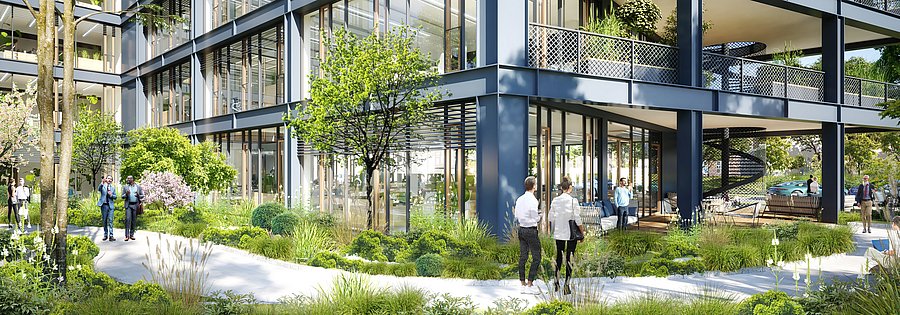Green Leases: What tenants and landlords can jointly contribute to environmental and climate protection
For some time now, CA Immo has been concluding so-called "green leases" almost exclusively. What does that mean?
The "green leases" are rental agreements in which, in addition to the usual economic details, we also include measures to help conserve our natural resources and the environment. By means of these "green" additional clauses, both contracting partners mutually agree to ensure that the operation of buildings and leased space is as environmentally and climate-friendly as possible. The background to this is that together with our tenants - who are, after all, the users of our buildings - we can operate the office buildings in a significantly "greener" way overall than if each party made efforts on its own. This partnership is needed for holistic environmentally and climate-friendly building operation.
What do these obligations look like for CA Immo and what can tenants contribute?
For example, we are committed to exclusively purchasing electricity from renewable energy sources for the building's operations. This includes, among other things, the electricity required for the building's entire cooling, ventilation, lighting and elevator systems. Depending on local availability, we also purchase renewably generated thermal energy, such as green district heating.
Furthermore, the energy efficiency of the building is crucial for resource-saving operation. We have been developing office buildings for our own portfolio for more than 10 years in compliance with strict, internationally recognized sustainability certificates such as DGNB or LEED. Almost our entire German portfolio is DGNB Gold or Platinum certified. High standards for energy efficiency are just one of many criteria here; these certificates also stipulate a wide range of other measures: be it, for example, the provision of covered and secured bicycle parking spaces and e-charging stations for bicycles, or a construction process that conserves resources and produces as few emissions as possible. The tenants, on the other hand, undertake, for example, to purchase green electricity for their rental space as well, or to use only environmentally friendly and resource-conserving materials for the space furnishings, to use environmentally friendly cleaning agents, or to create incentives for preferential use of public transportation (e.g., by offering job tickets).
A decisive approach for both sides, however, is energy monitoring in a spirit of partnership, i.e. data and information exchange as well as the analysis of energy and water consumption data to optimize energy consumption. To this end, we are equipping all our buildings with so-called smart meters. These are digital meters that enable both us as landlords and our tenants to monitor consumption in the rental spaces. This data transparency is a first step toward raising awareness and subsequently more efficient use of space by our tenants, but also an important basis for transparent and targeted energy management of the entire building.
How do tenants react to green leases and the associated environmental protection? What advantages do they see in green leases?
We were surprised at how positively tenants reacted to the Green Leases. There is an extremely high level of willingness to join us in setting an example for sustainability - this has also been demonstrated in the course of leasing our most recent project completions, the ONE office and hotel tower in Frankfurt and the grasblau office building in Berlin. Here, we have concluded exclusively green leases with our office tenants. You could almost say that tenants have been waiting for such leases. Of course, this is not entirely surprising, because our tenants benefit directly from the measures we have taken, for example through savings on utility costs. Many of our tenants have a strong ESG awareness themselves and want to show this to the outside world. Through our initiative, we provide them with corresponding data and evidence.
Last but not least, our tenants as well as ourselves see the benefits for the environment, e.g. by creating transparency of energy data to reduce CO2 emissions. Through the agreed measures, we are making a joint contribution to environmental protection.
Green leases can also be an important argument in the competition for employees, as today's generation is increasingly placing value on sustainability.
Based on the leases already signed, what can be said about the CO2 savings in the past year?
In 2020, we renegotiated all electricity contracts for building operations and switched to green electricity. Since the end of 2022, CA Immo has been purchasing only renewably generated electricity, e.g. from solar and wind energy, for its entire international portfolio. This will enable us to save just over 34,000 t of CO2 annually. Thanks to centralized purchasing, we were also able to negotiate extremely attractive terms, which of course benefits our tenants.
Thanks to these and other measures to increase energy efficiency, we have been able to reduce the average CO2 emissions intensity of our existing portfolio by around 50% compared with 2019.
What progress has CA Immo made so far in terms of decarbonization and how can tenants contribute?
Since January 1, 2022, CA Immo has been sourcing only renewably generated electricity, e.g. from solar and wind energy, for almost its entire international portfolio. CA Immo has also negotiated extremely attractive conditions for this, which naturally benefits tenants. The tenants of our buildings in Germany also have the opportunity to enter into these supply agreements for their rental space, thus not only benefiting from the favorable conditions but also making a significant contribution to reducing their C02 footprint.
Overall, these measures have enabled CA Immo to reduce the average CO2 emissions intensity of its existing portfolio by around 56% compared with 2019.

